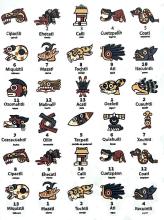tonalpohualli (FCbk4f55r)
tonalpohualli (FCbk4f55r)
This iconographic example from the Florentine Codex shows eight day signs (and their companion numbers) from the religious tonalpohualli (260-day divinatory calendar). This sample includes, starting from the top left: Ce Calli (One House), Ome Cuetzpalin (Two Lizard), Eyi Coatl (Three Serpent), Nahui Miquiztli (Four Death), Macuilli Mazatl (Five Deer), Chicuace Tochtli (Six Rabbit), Chicome Coatl (Seven Serpent, this one is out of order given that, in the normal order of days, atl or water would follow), and Chicuey Itzcuintli (Eight Dog). This book of the Florentine Codex discusses the pros and cons of being born on certain days in the calendar.
Stephanie Wood
See William L. Barnes' explanation of the two Aztec calendars (the tonalpohualli and the xiuhpohualli, counts of the days and the years, respectively) in his article published by Mexicolore, https://www.mexicolore.co.uk/aztecs/calendar/the-aztec-or-central-mexica....
The mistake in the order of the day signs is curious. Was this tlacuilo forgetting the old patterns? Sometimes, in the glyphs for names from the tonalpohualli in the 1560 Matrícula de Huexotzinco, either the number is omitted or the day name is missing, which could suggest a faulty memory. Another explanation in those cases could be that the tlacuilo was trying to disguise the fact that families had still been naming their babies by using the ancient calendar, with all of its Indigenous religious significance.
One could compare the presentation of this sampling of dates from the tonalpohualli with another group in the Códice Durán, found in a vignette published by Marc Thouvenot: https://vignettes.sup-infor.com/imagen/DU_03_320r_a.
Stephanie Wood
xiuhpohualli, año, turquesa, xihuitl, calendario, calendarios
This chart of day signs from the tonalpohualli (260-day religious divinatory calendar) shows the 20 hieroglyphs that are the day signs that combined with 13 numbers in a rotating fashion. The Templo Calendárico at the archaeological site of the main temple of Tlatelolco preserves these day signs with notations for specific dates of ritual significance at the time the temple was built. We present here a photo of an educational sign at the site, shot by S. Wood on 2 May 2025. The sign has been exposed to the elements, and so we have tried to “clean” it digitally. Many of the glyphs (which are from pre-contact times) vary somewhat from those found in manuscripts, while others in the manuscripts remain remarkably unchanged. Comparisons can be very valuable.
tonalpohual(li), the 260-day divinatory calendar, https://nahuatl.wired-humanities.org/content/tonalpohualli
cal(li), house or building, https://nahuatl.wired-humanities.org/content/calli
cuetzpal(in), lizard, https://nahuatl.wired-humanities.org/content/cuetzpalin
coa(tl), serpent, https://nahuatl.wired-humanities.org/content/coatl
miquiz(tli), death, https://nahuatl.wired-humanities.org/content/miquiztli
maza(tl), deer, https://nahuatl.wired-humanities.org/content/mazatl
toch(tli), rabbit, https://nahuatl.wired-humanities.org/content/tochtli
itzcuin(tli), dog, https://nahuatl.wired-humanities.org/content/itzcuintli
la cuenta de los días
Stephanie Wood
Florentine Codex, World Digital Library and Library of Congress, https://www.loc.gov/resource/gdcwdl.wdl_10615/?sp=111&st=image&r=0.588,0..., image 111 of 188.
The Library of Congress is unaware of any copyright or other restrictions in the World Digital Library Collection. Absent any such restrictions, these materials are free to use and reuse. Researchers are encouraged to review the source information attached to each item. If you do publish anything from this database, please cite the Visual Lexicon of Aztec Hieroglyphs.

